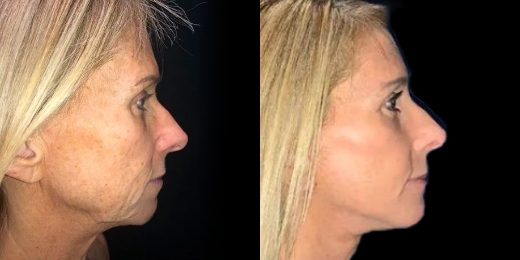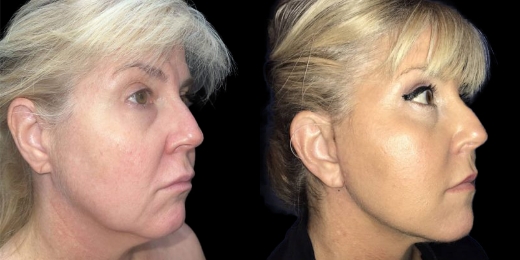Silicone vs. Saline Breast Implants
Consultations offered at our seven convenient locations in Manhattan New York City, Princeton New Jersey, Scarsdale, Woodbury Long Island, Southampton, Smithtown and Boca Raton, Florida

A Crucial Choice. There are many important variables to consider when planning a breast augmentation procedure, including silicone versus saline breast implants. Stephen T. Greenberg, M.D., F.A.C.S’s practice offers both types, because saline and silicone have mutually exclusive advantages that make one or the other more suitable for specific goals and preferences. The fundamental difference between these two types of breast implants is that saline implants contain a sterile solution of water and salt, while silicone implants contain a more dense silicone gel. After extensive testing, the U.S. Food and Drug Administration has determined that both saline and silicone implants are safe for use. Dr. Greenberg is an expert cosmetic surgeon who will take careful note as you describe the enhancement you wish to achieve, and then recommend the implants that will produce the bust line you desire. If you would like to learn more about the differences between saline and silicone breast implants, contact our practice today.
Contents
Texture
When it comes to achieving a natural look and feel, many women prefer silicone breast implants. Silicone gel is very similar in feel to natural breast tissue. The silicone gel maintains substantial outward pressure on the implant, helping it to retain a robust, natural shape. Saline, on the other hand, tends to reveal some rippling as it succumbs to the pressure of surrounding natural breast tissue. This principle makes silicone the implant of choice for women who are very thin, are undergoing breast reconstruction surgery, or have chosen to have their implant placed above the pectoral muscle. On the other hand, women who choose to place the implant below the pectoral muscle, or who have ample existing breast tissue, may be able to achieve satisfying results with saline implants.
Placement

Saline implants are filled after they are placed, while silicone implants are completely filled before surgery. Therefore, silicone implants require a larger incision than saline implants. In both cases, incisions are strategically placed so that any resulting scars will be well concealed and eventually become hardly noticeable.
Detecting Ruptures

Neither silicone nor saline implants are intended to last a lifetime. The longer a woman has implants, the more likely she will eventually need to undergo surgery to replace them. In the event of a rupture, the contents of a saline implant are absorbed safely into the body, and the rupture will be almost immediately apparent. If a silicone implant ruptures, the gel quickly escapes the implant, but stays within the pocket of tissue holding the implant in place. As such, it may go undetected until your next visit to your physician. The FDA recommends undergoing an MRI screening three years after breast augmentation surgery, and every two years after that.
Contact
The choice to undergo breast augmentation surgery is a very personal one that can boost a woman’s self-esteem, broaden her clothing options, and help her to feel attractive and confident. Dr. Greenberg prides himself on helping women achieve the very best breast augmentation results possible, and will take time to help you decide whether silicone or saline implants are the right option for you. Contact our practices serving Southampton, Smithtown, Woodbury, Scarsdale, New York City, Princeton, and Boca Raton to learn more.
FAQs
HOW LONG DO BREAST IMPLANTS TYPICALLY LAST?
Silicone and saline breast implants each have their own lifespan, typically ranging from 10 to 20 years. Silicone implants are known for their durability and tend to last longer than saline implants. However, both types of implants can rupture or leak over time, leading to potential complications and the need for replacement. Regular monitoring and follow-up appointments with a healthcare provider are essential to detect any issues early and ensure the longevity of the implants. Ultimately, the longevity of breast implants depends on various factors, including the individual’s body chemistry, lifestyle, and the quality of the implants themselves.
ARE SILICONE BREAST IMPLANTS SAFTER THAN SALINE?
Both silicone and saline breast implants are approved by regulatory authorities like the FDA, and neither is inherently “”healthier”” than the other in all cases. Rather, the choice between silicone and saline implants depends on factors such as personal preferences, medical history, desired aesthetic outcomes, and consultation with a qualified plastic surgeon who can provide tailored recommendations based on individual circumstances.
DO SILICONE OR SALINE IMPLANTS FEEL MORE NATURAL?
The perception of natural feel with breast implants can vary among individuals, but silicone implants are often considered to feel more like natural breast tissue compared to saline implants. Silicone implants have a softer and more pliable consistency that closely resembles natural breast tissue, while saline implants may feel firmer and less natural to the touch. However, the perception of naturalness can also depend on factors such as implant size, placement, and individual anatomy, and it’s essential to discuss your specific preferences and expectations with a board-certified plastic surgeon before making a decision.


